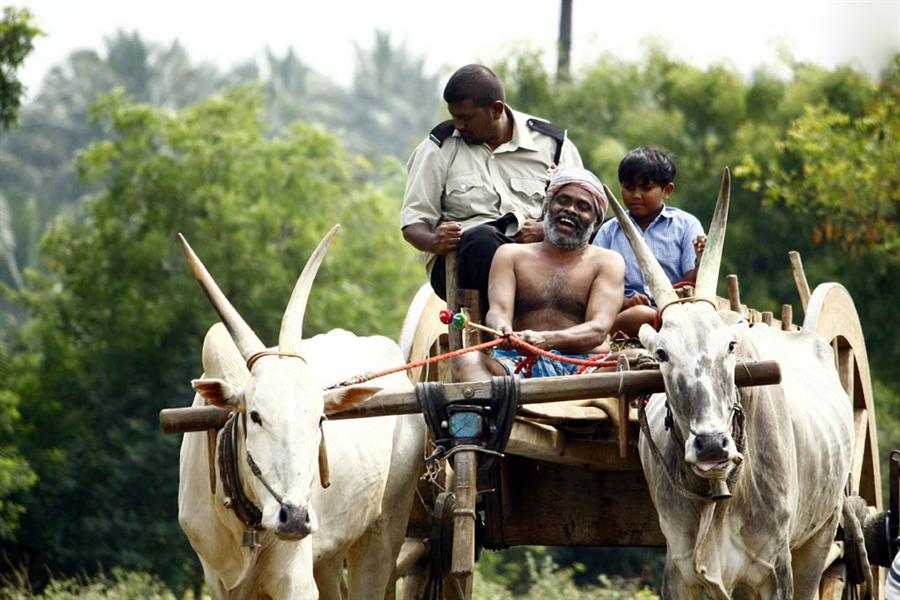A mentally challenged adult, Bhasker Mani (Mysskin), who escapes from a mental asylum and an eight-year old schoolboy Akhilesh (Ashwath Ram), are in search of their respective mothers. They meet up coincidentally and undertake their journey together. Their respective mothers had apparently abandoned them in their childhood. The former is searching for his mother to seek his revenge on her; the latter is searching for her to express his affection for her. On their journey, they come across many characters and events meant to offer philosophical, emotional, surrealistic and realistic shades of life.
The very first thing that strikes you about Nandalala is the amazing level of stylization in the shot taking and the way the actors are handled. The Director – Cinematographer – Editor combine has brought out a brilliant visual style to the film, which is raw (by Tamil film standards), simple and imaginative, with some excellent use of lensing. Extreme telephoto, extreme wide, high top angle, extreme low angle, low angle tracking shots, long duration static shots with minimalist activity, pauses kept longer than the ‘usual’, the way camera moves or stays with actors sometimes doing nothing as if arrested in time and action, are all the hallmarks of this film, which are expertly done.
Said to be based on the 1999 Japanese film Kikujiro, and possibly others, I would say the film is really a brave attempt by the director, Mysskin, who has already carved out a niche for himself within commercial Tamil cinema with his very unique methods of storytelling in Chithiram Pesuthadi (2006) and Anjaathey (2008). In this film too, Mysskin, apart from proving that he has a unique filmmaking style, has made a gallant attempt to do the lead role of Bhasker Mani himself, after failed attempts to get a lead actor to do this rather complicated, ‘non-hero’ role. He has an advantage here. When it comes to portraying a mentally deranged person, the director need not apologize for any sudden developments or lack of logic in the character. The notion of continuity, rationale or depth becomes subjective.
Though the story line is very promising on paper, with some brilliant nuances and accentuated caricaturing of all the characters on screen, when it finally boils down to the story as coming out from the structure, graph and development of the scenes and characters on the entire canvas, I found the film falls quite short of its attempted ambitious aim. After a point, the director looks foxed as to how to take the film forward. The film reaches a literal break down and looks completely lost once the search of the mothers reaches its physical destination – both stylistically and also with regard to character and story development. The purpose of the journey, which had a serious intent with philosophical and/or surrealistic possibilities, becomes sadly wasted. The film rolls on and ends rather compromised and tamely. Music Maestro Ilayaraja’s music and re-recording attempts to plug all the loop-holes but sounds like a salvage job. Mysskin in this film looks out of sorts in handling songs and seems to have simply abandoned it after some half baked efforts. The style of the shot taking and mis-en-scene, which was projected in high intensity throughout, doesn’t lead to anything other than becoming a prismatic monotony, repetition and an overkill.
Still, there are positives. The eccentric and sudden behavior of the mentally deranged person holding his pant up in one hand throughout the film, or the wise young boy in his school uniform, who draws out 100 rupees notes from his body all the time like a magician with his school bag and water bottle dangling on him through out his ‘journey’, the almost surrealistic and fantastic characters they encounter like the blind grand mother of Ashwat, the bald fat bike riders, police inspector, who is stunned speechless by the English speaking boy, the confused truck drivers wearing dark goggles, the tea shop owner, the coconut seller, the attractive lady in the car traveling with her husband, the boys having fun in a yellow car, the truck driver (Nasser) who enjoys sleeping while driving, communal/caste rioters in an open field seen in long distance wide angle (with no inter-cuts), a prostitute, Anjali (Snigdha) who graduates to become an adopted mother, the chained, mentally deranged mother (Rohini) of Bhasker – all of them add a great range and a variety of shades to the storyline, making it almost look like a folk tale or a dream.
All in all, a courageous effort that needs to be lauded even if the filmmaker hasn’t quite pulled it off as well as he should have.
Tamil, Drama, Color


